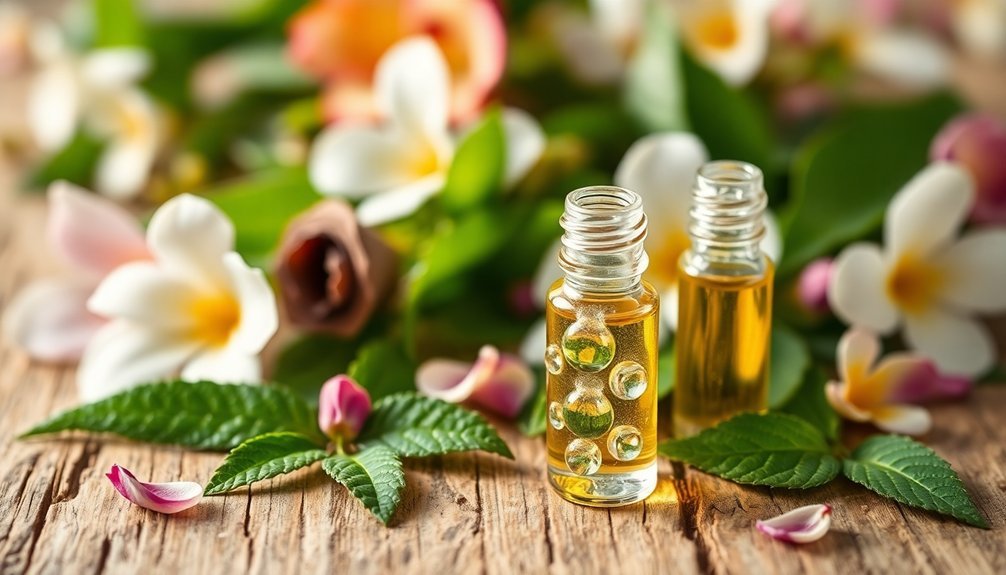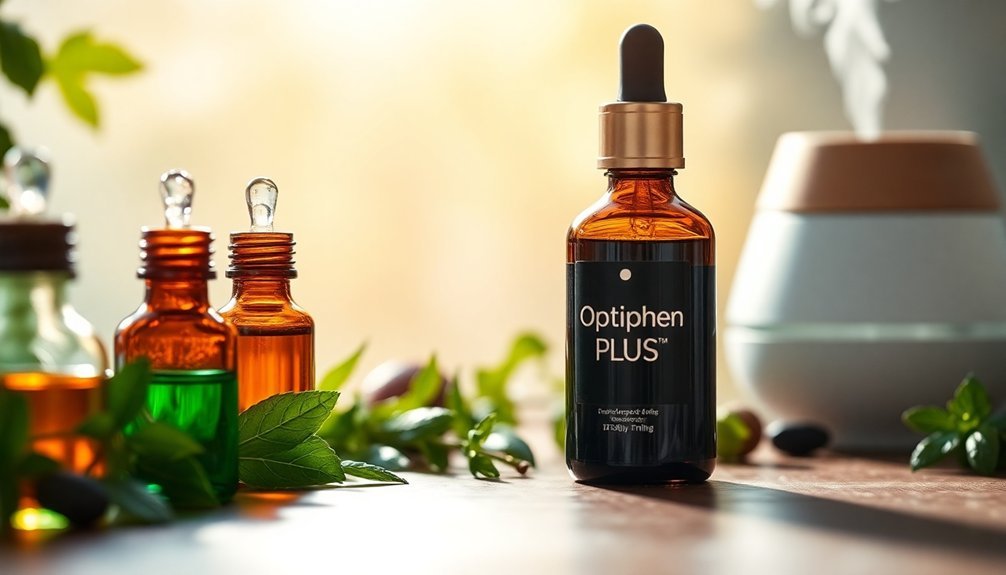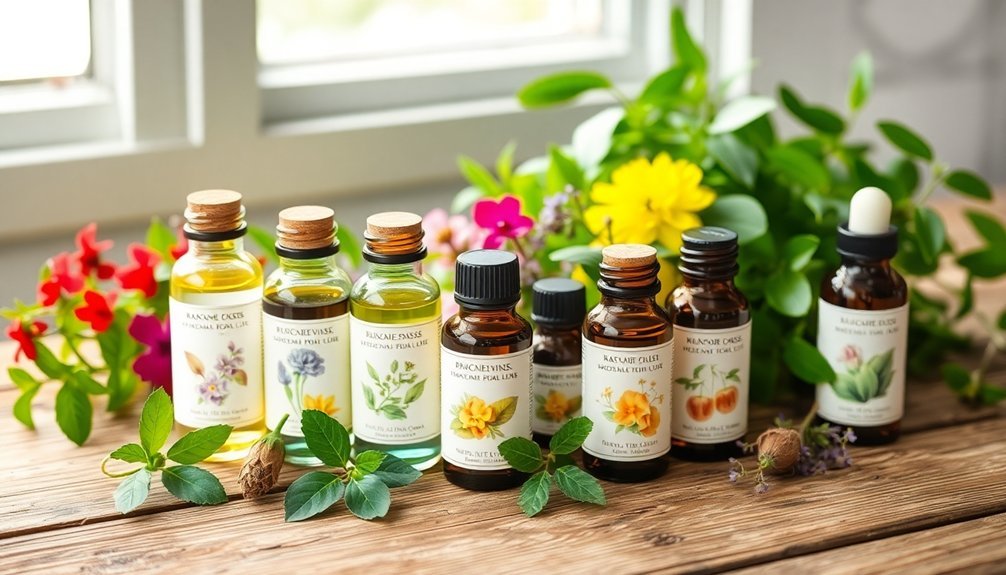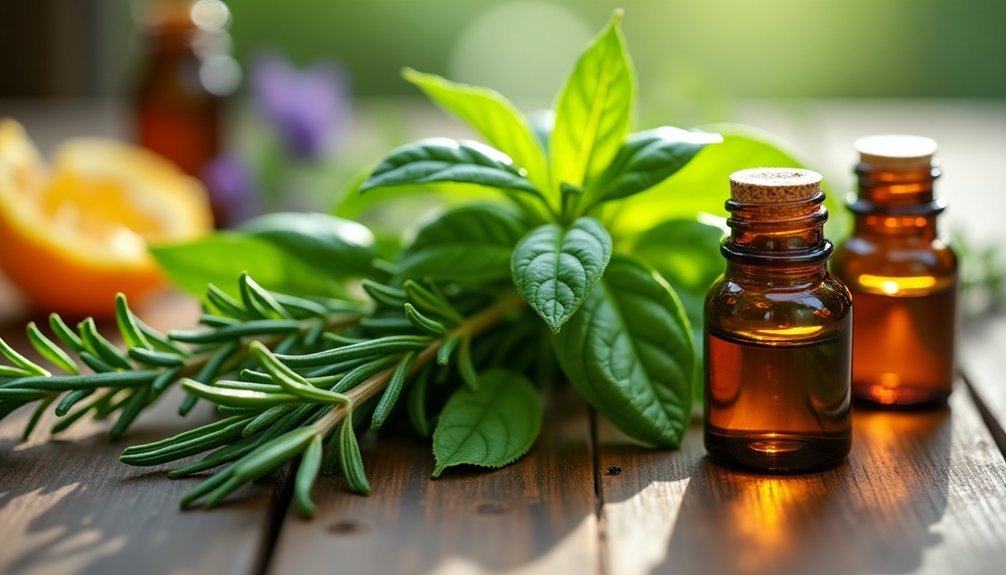For preserving essential oil scents naturally, you'll want to take into account Leucidal Liquid or Optiphen Plus as your primary plant-based preservatives. Leucidal Liquid, derived from Korean kimchi, works best at 2-4% concentration and offers broad-spectrum protection while maintaining fragrance integrity. Optiphen Plus excels when used at 0.75-1.5% in formulations with pH below 6.0. You can enhance preservation by combining these with citrus essential oils, which offer their own antimicrobial properties. Understanding the complete preservation system will help you create longer-lasting natural fragrances.
Understanding Plant-Based Preservatives in Perfumery

While creating natural perfumes requires careful attention to ingredients, understanding plant-based preservatives is essential for ensuring your formulations remain safe and stable.
You'll need to protect your scents from microbial contamination, especially in water-based formulations where bacteria and mold can thrive.
Consider using natural preservatives like benzyl alcohol combined with organic acids, which offer broad-spectrum protection.
You'll find that glyceryl caprylate and plant-derived options like salicylic acid work effectively while meeting ECOCERT standards.
When selecting your preservative system, you'll want to check its pH stability, solubility, and compatibility with your other ingredients.
Don't forget to incorporate antioxidants like vitamin E or rosemary extract – they'll help prevent oxidation and extend your perfume's shelf life while supporting your preservation system.
Testing through external laboratories can validate your preservative system's effectiveness before launching your perfume products.
The Role of Leucidal Liquid in Essential Oil Blends
When you're working with essential oil blends, Leucidal Liquid's natural antimicrobial properties make it an excellent preservative choice that meets organic certification standards.
You'll find it maintains stability with essential oils while providing broad-spectrum protection against bacteria, yeast, and mold at temperatures up to 70°C.
Its ECOCERT/COSMOS approval guarantees your essential oil formulations stay compliant with natural standards while benefiting from its proven preservation capabilities. For optimal results, use at a 2-4% concentration level in your formulations.
Natural Antimicrobial Properties Benefits
As natural skincare enthusiasts seek safer alternatives to synthetic preservatives, Leucidal Liquid has emerged as a groundbreaking solution for essential oil blends.
You'll find this innovative preservative, derived from Korean kimchi's beneficial bacteria, offers powerful protection against harmful microorganisms while enhancing your formulation's moisturizing properties. Its effectiveness is further enhanced by water-soluble undecylenates that boost its antimicrobial capabilities.
What makes Leucidal Liquid particularly impressive for your essential oil blends:
- It's proven to eliminate 99.9% of microbial contaminants within just 7 days, keeping your blends fresh and safe.
- You can incorporate it at 2-4% concentration for broad-spectrum protection against bacteria, yeast, and mold.
- You'll get the added benefit of enhanced moisturization, with studies showing a 10% increase in skin hydration.
This ECOCERT-approved preservative works seamlessly in various formulations, making it an ideal choice for your natural skincare products.
Stability With Essential Oils
Since essential oils can be challenging to preserve in water-based formulations, Leucidal Liquid offers remarkable stability and compatibility advantages. You'll find it works effectively at pH levels below 9 and temperatures up to 140°F, making it suitable for various essential oil blends. When you're formulating, add it at 2-4% during the cool-down phase for best results.
| Feature | Benefit | Application |
|---|---|---|
| Water-soluble | Easy integration | Lotions & creams |
| Heat stable | Versatile processing | Oil-water blends |
| Broad-spectrum | Complete protection | All natural products |
For best results, you'll want to store your Leucidal Liquid in an airtight container away from light. When properly formulated, it provides one year of preservation while maintaining the integrity of your essential oil blends, especially when paired with antioxidants.
Organic Certification Standards
Most essential oil products seeking organic certification must meet rigorous USDA standards, even though the oils themselves aren't directly regulated. For your product to earn organic certification, at least 95% of its content must be organic by weight, excluding water and salt.
When you're using Leucidal Liquid as a preservative in your organic essential oil blends, you'll be pleased to know it's ECOCERT certified and compliant with organic standards.
Here's what makes it an excellent choice:
- It's naturally derived from fermented radishes, supporting sustainable farming practices
- You can trace it back to its source, ensuring transparency in the production process
- It provides broad-spectrum protection against bacteria, yeast, and mold without synthetic chemicals
Annual inspections and third-party testing help maintain these high organic standards, giving you confidence in your product's quality.
Combining Optiphen Plus With Fragrant Oils

When working with Optiphen Plus and fragrant oils, you'll need to maintain a pH below 6.0 to guarantee ideal preservation effectiveness.
You should carefully measure your ingredients to achieve the recommended usage rate of 0.75-1.5% Optiphen Plus in your total formulation.
For the best results with essential oils, pre-mix your Optiphen Plus with a compatible solvent like polysorbate 80 before combining it with your fragrant ingredients.
Ph Balance Is Key
Understanding the pH balance of your hydrosols plays an essential role in maximizing their shelf life with Optiphen Plus and fragrant oils.
You'll get the best results when your hydrosol's pH stays at or below 5.0, as this can extend preservation up to two years compared to just 12-18 months with higher pH levels.
Monitor your hydrosol's condition by:
- Testing and recording pH levels at purchase
- Watching for pH changes that might indicate contamination
- Checking regularly for visual signs of degradation
When combining Optiphen Plus with fragrant oils, you'll need to maintain proper pH levels to guarantee the preservative works effectively.
The natural antimicrobial properties of essential oils can work synergistically with Optiphen Plus, but don't oversaturate your mixture, as this could compromise the product's stability and scent profile.
Maintaining Proper Ratios
Beyond pH balance, proper ratios form the foundation of successful preservation with Optiphen Plus and fragrant oils.
You'll need to maintain usage rates between 0.75% and 1.5% of your total formulation. For home-based creation, stick to the higher end at 1.5% to compensate for non-sterile conditions.
When working with fragrant oils, you'll want to pre-distribute Optiphen Plus in a compatible solvent like propylene glycol or glycerin before combining it with your essential oils.
This guarantees proper dispersion and maximum effectiveness. For a 100g batch, add 1.5g of Optiphen Plus to your solvent first, then blend with your oils.
Don't exceed the 1.5% maximum, as higher concentrations won't improve preservation and could waste product.
Remember to add your preservative mixture during the cool-down phase, keeping temperatures below 80°C.
Essential Oil Pairing Tips
Successful pairing of Optiphen Plus with essential oils requires careful attention to both pH levels and stability factors.
You'll need to maintain a pH below 6 and guarantee proper dispersion through intensive stirring. Pre-distribute your preservative in glycols or glycerin for better results, and be prepared to adjust your formulation as needed.
- Mix Optiphen Plus thoroughly into your base before adding essential oils to prevent destabilization.
- Use high shear blending after adding both components to maintain proper texture.
- Consider cooling your emulsion below room temperature for several hours if stability issues arise.
When adding your essential oils, you'll want to test the fragrance strength gradually.
Since Optiphen Plus has minimal scent, you can focus on achieving your desired aroma without worrying about preservative interference.
Remember to monitor your mixture's stability over time.
Natural Antimicrobial Properties of Citrus Oils
Known for their robust antimicrobial properties, citrus essential oils have emerged as powerful natural preservatives in food applications.
You'll find that lime oil stands out with impressive results against Salmonella, creating inhibition zones of 11.5 mm, while lemon and lime oils effectively combat Listeria with zones reaching 17.4 mm and 17.0 mm respectively.
The secret lies in their rich limonene content, which can comprise up to 61.62% of lemon oil's composition.
When you combine these oils with acetic acid, you'll get enhanced preservation power through their synergistic effects.
You can safely add lemon oil to fresh cream at 0.125% to 0.5% concentrations without affecting flavor, or incorporate it into edible films for bread, cheese, and fruits to extend shelf life naturally.
Optimal Storage Conditions for Preserved Scents

Your preserved plant-based scents need a consistently cool environment, away from heat sources and temperature fluctuations that can break down their chemical composition.
You'll get the best results by storing your fragrances in dark glass bottles and keeping them in cool, dark spaces like interior closets or drawers.
If you're looking for maximum protection, you can store your scents in a clean refrigerator while ensuring they're tightly sealed to control humidity exposure.
Temperature Control Matters Most
Maintaining the right temperature stands as the most critical factor in preserving essential oils and plant-based scents.
You'll find that storing your oils at around 72 degrees Fahrenheit helps maintain their potency and chemical composition. When temperatures fluctuate or rise too high, your oils can quickly lose their effectiveness through evaporation and oxidation.
- Keep your oils in a cool, dark place like a refrigerator to maintain consistent conditions
- Remove oils from cold storage 1-2 hours before use to let them reach room temperature
- Verify bottles are tightly sealed with their plastic fitments intact to prevent air exposure
For long-term storage, you can safely use your freezer – don't worry if some oils crystallize, as they'll return to normal once thawed.
Remember that controlled temperatures greatly slow down oxidation and preserve your oils' original properties.
Light Exposure Prevention Tips
When storing essential oils and plant-based scents, protecting them from light exposure proves just as crucial as temperature control. You'll want to keep your oils in dark places, away from windows and direct sunlight, as UV rays can quickly break down their chemical compounds and alter their original scents.
| Storage Location | UV Protection | Best Practices |
|---|---|---|
| Dark Cabinets | High | Use interior spaces |
| Refrigerator | Excellent | Store in small batches |
| Drawers | High | Label and date bottles |
| Closets | Good | Rotate stock regularly |
| Special Containers | Variable | Choose UV-protected materials |
For photosensitive oils, you'll need extra precautions. Apply these at night or cover treated skin areas with protective clothing. If you must use them during the day, avoid peak sun hours and store them in UV-protected containers to maintain their potency.
Creating Long-Lasting Natural Perfumes
Creating long-lasting natural perfumes requires a strategic blend of proper storage, application techniques, and thoughtful ingredient selection.
You'll want to keep your perfumes in a cool, dark place and guarantee bottles are tightly sealed to prevent oxidation. When applying, focus on pulse points after moisturizing, and don't rub your wrists together, as this speeds up evaporation.
To maximize your perfume's longevity, consider these key elements:
- Use natural fixatives like frankincense, oud, or vetiver to slow down evaporation
- Increase the concentration of essential oils up to 40% for stronger staying power
- Add a few spritzes to your moisturizer or hair for extended wear time
For best results, opt for alcohol-based formulations over oil-based ones, as they typically provide better preservation and lasting power on your skin.
Essential Oil Compatibility With Preservatives

Despite their beneficial properties, essential oils can't serve as standalone preservatives in water-based formulations. While they offer antioxidant benefits, they won't prevent microbial growth in your products.
You'll need compatible natural preservatives to guarantee your essential oil creations stay safe and stable. Consider using Optiphen Plus for low pH formulations or Leucidal Liquid, derived from fermented radishes, for strong antimicrobial protection.
If you're working with anhydrous products like roll-ons or balms, you won't need preservatives at all.
For water-based formulations, you can enhance preservation by combining different approaches. Try using encapsulation technology, maintaining proper pH levels, and selecting preservatives like Caprylyl Glycol EHG or Potassium Sorbate.
When used correctly, these preservatives will protect your essential oil products without compromising their natural benefits.
Small-Batch Perfume Making Techniques
Small-batch perfume making allows you to craft unique, personalized scents while maintaining the natural properties of your essential oils.
Start by understanding the fragrance notes and using high-percentage alcohol as your base. You'll need to carefully dilute your essential oils with a carrier oil, keeping the concentration at 5% or less for safety.
When creating your blend, remember these key techniques:
- Mix your ingredients in dark glass containers using droppers for precise measurements
- Start with small quantities and adjust gradually until you achieve your desired scent
- Let your blend age for several weeks to allow the notes to meld together
Always test your creation on a small patch of skin before use, and store your finished perfume in a cool, dark place to preserve its integrity.
Preservative Systems for Water-Based Scents

When working with water-based scents, you'll need an effective preservative system to protect against microbial growth and guarantee product safety.
For natural options, consider using OptiphenTM BSB-W, which combines benzyl alcohol, sodium benzoate, and potassium sorbate. This nature-identical preservative works best at pH levels below 5.4.
You can also use grain alcohol if it makes up at least 20% of your formulation.
When selecting a preservative, you'll need to match it with your product's pH level and ascertain it's water-soluble. If you're making small batches, you can reduce contamination risks by maintaining sterile conditions and regularly remaking your products.
Don't forget to test your preservative system's effectiveness and consider adding boosters or antioxidants to enhance protection against bacteria, yeast, and mold.
Organic Preservation Methods for Aromatics
While essential oils like tea tree, oregano, and thyme possess antimicrobial properties, they can't serve as standalone preservatives for aromatics. You'll need a thorough approach that combines natural preservatives with enhancers for effective organic preservation.
Consider these plant-based preservation options:
- Leucidal Liquid from radish root ferment provides antimicrobial protection
- Aspen bark extract works effectively in a pH range of 3.0-9.0
- P Anisic Acid offers preservation at low concentrations between 0.05-0.3%
When selecting organic preservatives, prioritize those from certified organic or wildcrafted sources to promote sustainability and purity.
You'll achieve better results by combining preservatives with potentiators like nonionic surfactants or Caprylyl glycol.
Remember that essential oils can still contribute to your formula at 1-2% for fragrance while supporting the overall preservation system.
Selecting the Right Preservative for Your Blend

Building on our knowledge of organic preservation methods, selecting an appropriate preservative for your blend requires careful consideration of multiple factors.
You'll want to focus on natural options like Leucidal Liquid, which offers strong antimicrobial properties and meets organic certification standards.
Don't fall for common misconceptions about preservatives. While essential oils, vitamin E, and grapefruit seed extract are beneficial antioxidants, they won't prevent microbial growth in your blends.
Instead, consider Caprylyl Glycol EHG or Potassium Sorbate for water-based formulations, ensuring you match the preservative to your product's pH level.
If you're making anhydrous products like roll-ons or balms, you won't need preservatives at all.
Remember to conduct proper testing and follow supplier recommendations to guarantee your blend's safety and stability.
Safety Guidelines for Natural Perfume Preservation
Proper storage and handling practices form the foundation of natural perfume preservation safety.
You'll want to store your fragrances in a cool, dark place away from direct sunlight and fluctuating temperatures. Keep your perfumes in their original containers with tight-fitting lids, as repackaging can expose them to unnecessary oxidation.
For ideal preservation, follow these essential guidelines:
- Never leave bottles uncapped for long periods – instead, quickly apply and seal them to prevent air exposure
- Choose stable environments away from bathrooms, windowsills, and heat sources
- Label all containers with the fragrance name and opening date to track freshness
Remember to gently roll bottles instead of shaking them, and opt for smaller containers for daily use to minimize exposure to air and environmental factors that could compromise your natural perfumes.
Frequently Asked Questions
Can Plant-Based Preservatives Affect the Therapeutic Properties of Essential Oils?
You'll find that plant-based preservatives generally don't diminish essential oils' therapeutic properties. In fact, they can enhance their efficacy by protecting bioactive compounds and creating synergistic effects that boost overall benefits.
How Long Does It Take for Natural Preservatives to Start Working?
You'll notice natural preservatives begin working immediately, but they'll reach maximum effectiveness within 48-96 hours. Keep in mind they need continuous presence to maintain their protective effects throughout your product's shelf life.
Do Essential Oil Concentrations Need Adjustment When Using Plant-Based Preservatives?
Yes, you'll need to adjust essential oil concentrations when using plant-based preservatives. The preservative's pH range, temperature stability, and recommended usage levels can affect how much essential oil you should include in your formulation.
What Are Signs That Plant-Based Preservatives Have Stopped Working Effectively?
You'll notice your product has spoiled when you detect off smells, see visual changes like mold or separation, feel textural differences, or experience skin irritation. These signs mean your plant-based preservatives aren't working anymore.
Can Different Plant-Based Preservatives Be Mixed Together for Stronger Protection?
You can mix compatible plant-based preservatives to enhance protection, but you'll need to carefully test combinations for pH stability and effectiveness. Don't exceed recommended concentrations, as this won't improve preservation.
In Summary
You've learned key strategies for preserving your essential oil blends naturally and safely. By choosing plant-based preservatives like Leucidal Liquid or leveraging the antimicrobial properties of citrus oils, you'll extend your scents' shelf life while keeping them pure. Remember to store your preserved blends properly and always test new preservation systems on small batches first. With these tools, you're ready to create lasting natural fragrances.





Leave a Reply